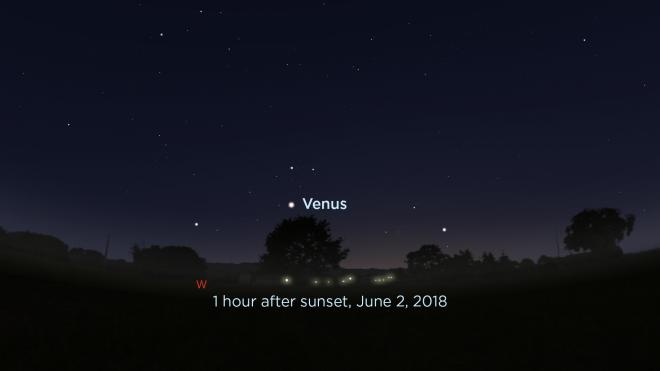The bright point of light in the west after sunset is Venus
June 7, 2018
By Amy Sayle
Have you been noticing a very bright point of light in the western sky after sunset? It’s Venus. (Unless it’s noticeably moving, in which case it’s probably an airplane.)
If you haven’t seen Venus yet, try going outside in evening twilight and looking toward the same direction that the Sun set. As long as clouds, trees, or buildings don’t block your view, you’ll see Venus. This planet is very bright, noticeably brighter than any star in the night sky. But don’t mistake it for bright Jupiter, which lies in the southeast at nightfall.

This means that in the night sky you can see Venus only in the west after sunset, or in the east before sunrise. (Unless you are the fictional character Robert Langdon in Dan Brown’s book The Da Vinci Code, in which case apparently you can see Venus flung right out of its orbit.)
In recognition of this phenomenon, a story from west central Africa portrays Venus as two different wives of the Moon, one who lives in the west, and one who lives in the east.
According to the version of the story related in E. C. Krupp’s book Beyond the Blue Horizon, the Moon likes to visit his western wife, Puikani, in the evening twilight. She loves to cook, so when he’s with her, he gets fatter and fatter.
Then he’ll hang out with his eastern wife, Chekechani, in the morning twilight. She doesn’t cook, and apparently he doesn’t either, so he gets thinner and thinner.
That, says the story, is why the moon waxes and wanes.
On June 15 and 16, 2018, step outside after sunset and you’ll see the waxing crescent Moon pay a visit to Puikani in the western evening sky. As the Moon appears to pass from one side of Venus to the other over those two evenings, watch him fatten up slightly, into a thicker crescent.
Venus stays a so-called “evening star” in the west through summer 2018. Then the planet will pass in front of the Sun and be lost for a while in the solar glare before re-emerging in mid-November into the eastern morning twilight.
If you’d like to view Venus and other celestial wonders alongside some of your fellow Earthlings, please join us for a skywatching session this summer. Find details and directions at Morehead’s skywatching page.
